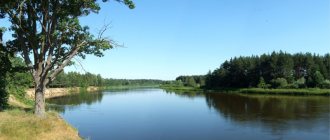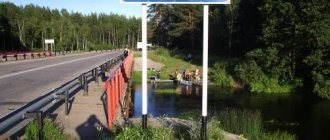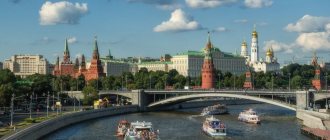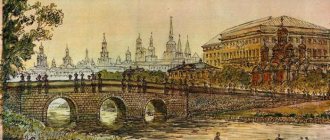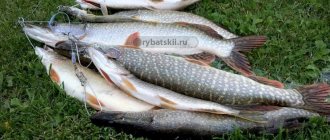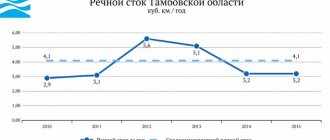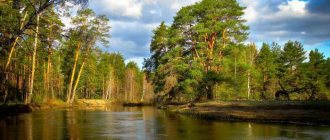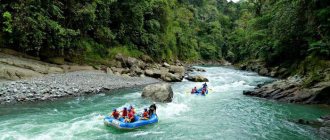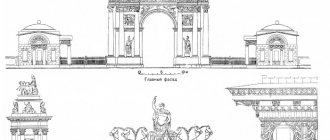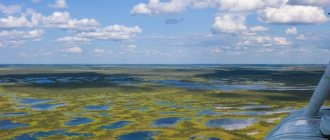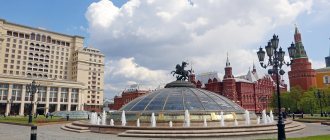The Pripyat River is the largest and most important right tributary of the Dnieper. Its length is 775 kilometers. The water flows through Ukraine (Kiev, Volyn and Rivne regions) and Belarus (Gomel and Brest regions). The drainage basin area exceeds 114 thousand square kilometers. Pripyat originates between the villages of Rogovye Smolyary and Budniki on the Volyn Upland. In the upper reaches of the river its valley is expressed rather weakly, in the lower reaches it is somewhat more distinct. The width of the floodplain in the upper reaches does not exceed 4 kilometers, in the lower reaches - up to 15. The slope of the river is 0.08 meters per 1 kilometer. In the upper reaches the Pripyat riverbed looks like a canal; below it becomes winding. In the middle reaches there are many oxbow lakes and meanders, the river has many channels and small islands. The width of the water flow at the sources is no more than 40 meters, at the Kyiv reservoir, where the Pripyat River flows, up to 5 kilometers.
River life
The Pripyat River has mixed water supply, mainly from snowmelt. Its regime is characterized by long floods in the spring. It begins in early March, and in cold years - in mid-April. The flood can last up to 3.5 months. Accompanied by large-scale spills. At this moment, in the upper reaches the water can rise by 2 meters, in the middle - by 3.5, and in the lower reaches - up to 7 meters. Summer low water is short-lived, as it is constantly interrupted by rain floods. Autumn is almost every year characterized by a significant rise in water. The annual flow is 14.5 cubic kilometers. Of these, up to 65% occur in the spring. Pripyat freezes only in mid-December. There are many swamps in the river basin, which determine the color of the water in the river.
Geographic summary
Take a look at the map: the Pripyat River is represented by a thin winding line, encircling the relief surface of several states, mainly Ukraine and Belarus. A striking feature of Pripyat is the meanders and oxbow lakes formed by it, which are conveniently located at the lower reaches of the river bed. The smooth curves of the floodplain lakes form an expressive picture - if you take the opportunity to look at it from a bird's eye view.
Bird's eye view of the river
In early spring, when the flood period begins, the water level in the river rises significantly. However, this period is replaced by summer low water - a decrease in the water level in the Pripyat River. The low-water phase is short-term and can last from 10 to 120 days.
In winter, the river is covered with a thin blanket of ice. At this time, Pripyat is especially beautiful: the snow-white radiance of the cover, the pleasant ringing of frozen tree branches bending over the river, and the high sun, which gleams across the entire river area, are impressive.
Pripyat River near the Chernobyl Nuclear Power Plant
Water flow location
The Pripyat River on the map begins in the Lyuboml district of the Volyn region of Ukraine, along which it flows 204 kilometers. Then the water flow crosses the border of Belarus and follows the Polesie Lowland for 500 km. His path runs through the Pinsk swamps. Here the valley is poorly defined, the banks are swampy. The river often breaks into branches. At the beginning of the lowland, the bottom is unstable and sandy; towards the end, the number of riffles on the river increases. For the remaining 50 kilometers, the Pripyat flows again into Ukraine, where it ends its journey in the Kiev Reservoir, just south of Chernobyl. The river is connected by canals to Mukhavets (a tributary of the Western Bug) and Shchara (a tributary of the Neman). The Pripyat River is flat. It is characterized by low swampiness - up to 15%.
Tributaries, settlements, lakes and canals of Pripyat
The Pripyat River has many tributaries, but the most important are the Ptich, Styra and Goryn. The latter is the largest water flow (of the flowing ones). The Dnieper-Bug Canal ultimately connects Pripyat with the Bug, thus forming a waterway to Europe. Or the Black Sea and the Baltic. The Dnieper-Neman Canal makes the river part of the route from Ukraine to Latvia - to the Kaunas Reservoir. There are other non-navigable "small" canals. The Polesie lowland is characterized by large lakes. There are more than 2.5 thousand lakes on the right bank of Pripyat alone. The largest on the river are two Belarusian cities - Mozyr and Pinsk. The two most famous Ukrainian settlements are the “dead cities” of Pripyat and Chernobyl.
Pripyat River and its tributaries
- VK
The Pripyat River is 748 km long. Only its upper reaches (over 186 km) and lower reaches (80 km) are located within Ukraine; the rest flows through the territory of Belarus.
The river flows from the swamps in the west of the Volyn region. Its flow is slow, as it flows through lowland areas, most often covered with loams and clays, as well as peat deposits. The floodplain is wide and swampy. The width of the channel in the upper reaches is 30-40, in the lower reaches from 200 to 500 m. The largest part of the water flows in the spring. Since in winter the Pripyat is fed mainly by waters of marsh origin, rich in humic and ferrous substances, the oxidation of which consumes oxygen, the river often experiences starvation phenomena that extend to the Dnieper.
During the spring flood, the river overflows its banks, flooding vast areas. Due to the fact that the terrain here is low-lying and flat, and the flow of the river is slow, numerous swamps and lakes have formed in the floodplain. Pripyat collects water from wetlands, which is why its water is dark brown in color. The river has many branches and channels. In spring, its waters flood large areas. Pripyat pours into the Dnieper as much water as the Dnieper carries before its confluence with Pripyat. Currently, a significant part of the Pripyat mouth area is flooded with the waters of the Kyiv Reservoir, and therefore it has turned into its reach.
What will fishing on the Pripyat River bring?
In the upper reaches of the Pripyat, the fish population is represented by pike, roach, dace, chub, ide, rudd, bunting, gudgeon, bleak, silver bream, bitterling, char, spined loach, loach and perch. In the lower part of Pripyat there are numerous pike, roach, ide, podust, silver bream, bream, white-eye, bluefish, sabrefish, perch, and ruff; less common are rudd, asp, tench, bleak, crucian carp, catfish, pike perch, nosefish, dace, chub, fisherman, carp, loach, burbot and some other fish.
The largest right tributaries of the Pripyat - Turiya, Stokhod, Styr, Goryn, Ubort, Slovechna and Uzh - originate in the territory of Ukraine, pouring their waters into the Pripyat on the territory of Belarus, except for Turiya and Stokhod. Their interfluves, partly in the middle reaches and especially in the lower reaches, are connected during spring floods.
The Turia River begins south of the village. Zaturtsy Volyn region and pours its waters into Pripyat near the village of Pochapy in the same region. Its length is 184 km. The width of the channel in the upper reaches does not exceed 3-4 m, in the middle and lower reaches it reaches 15-20 m, expanding in places to 40-50 m. The spring flood lasts over a month. At this time the river floods heavily. Summer low water is disrupted by rainfall. There are reservoirs on the river, the waters of which are used both for water supply and for generating electricity. The tributaries of the Turii - the Bobrovka, Rudka and Durnitsa rivers - are small, their length does not exceed 20-25 km.
In the Turiy River, pike, roach, ide, oatmeal, bleak, silver bream, bitterling, and perch are common. There are also dace, rudd, tench, gudgeon, bream, char, loach, spined loach, etc.
The Stokhod River flows from Lake Lukovoe in Volyn. Its length is 188 km. The riverbed in many places strongly branches, forming channels and numerous floodplain reservoirs. The width of the channel does not exceed 10-15 m, in the lower part it increases to 40-60 m, and in the spring the river is even navigable. Forests occupy almost a fifth of the basin's area.
The Stokhod River is home to pike, roach, dace, ide, oatmeal, gudgeon, bitterling, as well as rudd, podust, bleak, silver bream, bream, spined loach, perch and ruff.
The Styr River begins in the Lviv region, flows through the Rivne and Volyn regions and flows into Pripyat in Belarus. Its length is 483 km. The width of the channel is from 2-3 m in the upper section to 30-50 m in the middle and lower sections. During the flood period, the water level can rise in the upper reaches to 4-5 m, in the lower reaches - up to 3 m. The banks of the river are predominantly low-lying, swampy, low, the bottom is made of peaty soils. Both on the Styra itself and on some of its numerous tributaries - Boldurka (37 km), Slonovka (47 km), Lipa (43 km), Ikva (155 km), Chernoguzka (49 km), Serna (34 km), Konopelka (48 km), Okonka (38 km), Cormin (53 km), Stubla (62 km) - there are dams. Styr in the middle and lower reaches is navigable.
The most common fish for it are pike, roach, dace, ide, oatmeal, silver bream, bream, gudgeon, bleak, bitterling, and perch.
The Goryn River , one of the largest right tributaries of the Pripyat, has a length of 659 km. It starts near the village. Volitsa of Ternopil region. The upper reaches of the Goryn are located on the Volyn-Podolsk Upland, composed of rocky rocks, and therefore the width of the channel here ranges from 3 to 10 m; the banks are steep. In the middle reaches, the width of the channel increases to 20-30 m, and in the lower reaches it exceeds 100 m. The banks are low and peaty. In many places, the floodplain is cut by tributaries and old channels that have turned into lakes and swamps. In the upper and middle reaches of the river there are many river-bed ponds and small reservoirs.
Goryn joins Pripyat on the territory of Belarus. The largest tributaries of the Goryn are the Polka (43 km), Tsvetoka (39 km), Viliya (77 km), Ustya (68 km), Stubazka (86 km), Zulanya (40 km), Yuzhnaya Sluch (45 km), Siren (51 km). Most of them originate in the Volyn-Podolsk Upland. Their channels are narrow, the banks are steep, the currents are fast, and the bottom is composed of sand and rocky rocks.
Among the fish in the Goryn River and its tributaries there are roach, dace, ide, rudd, bunting, podust, gudgeon, bleak, silver bream, bream, bitterling, perch, less often - pike, chub, asp, tench, quicksand, sabrefish, white-eye, pike perch , ruff and nose.
The Sluch River is the largest tributary of the Goryn, length - 451 km. Its channel in the upper reaches is winding, the bottom is mostly rocky, and the current is fast. Below the city of Novograd-Volynsky, crystalline rocks disappear, the flow of the river slows down, the valley expands, the banks become low, the width of the river increases from 20-50 to 110 m. The bed of the Slucha, like the Goryn, is blocked by dams in many places.
The fish population of the Sluchi River is represented by pike, roach, dace, chub, oatmeal, gudgeon, podust, bleak, silver bream, bream, fisherman, bitterling, crucian carp, pike perch, perch, ruffe, nosar, char, spined loach and some other species.
The Ubort River has a length of 256 km. It originates from the village of Andreevichi in the Zhytomyr region. In the upper reaches, the width of the channel does not exceed 10-20 m. The banks are high, sometimes rocky, not swampy. In its lower reaches, the Ubort is a typical Polesie river with swampy banks. Its largest tributaries are the Percha (87 km), Svidovets (58 km), Glumcha and Zolnya (24 km each). There are dams on the Uborti riverbed and on some of its tributaries.
The Uborti River is home to pike, roach, dace, chub, ide, oatmeal, gudgeon, bleak, bream, bitterling, and perch. Less common are rudd, tench, quicksand, silver bream, crucian carp, burbot, ruffe, char, spined loach, and loach.
The Uzh River is the last large right tributary of the Pripyat. The left tributaries are located outside of Ukraine. The Uzh River begins at the village. Sorochen in the Zhytomyr region and flows into the Pripyat near the city of Chernobyl in the Kiev region. Its length is 256 km. The river bed in the upper reaches is narrow, the banks are often rocky, and the current is fast. In the lower part, the banks are made of sand and are swampy. The width of the channel reaches 70 m. The largest tributaries are Zherev (105 km), Norin (84 km), Ilya (48 km) and Veresnya (58 km). On the rivers of the Uzha basin, dams have been built in some places, mainly in the upper reaches.
Common fish in the river are pike, roach, dace, chub, ide, oatmeal, gudgeon, bleak, silver bream, bream, and perch. Less common are minnow, podust, rudd, asp, crucian carp, burbot, char, and spined loach.
Related articles:
Desna River and its tributaries
Lake Svityaz
The influence of weather on fish biting
Kanevskoye Reservoir
Chernobyl
On the territory of the Chernobyl exclusion zone, Pripyat is the largest water body. The river bypasses the area from the east and then flows into the Kiev Reservoir. Directly in the location area, the riverbed was artificially changed. Today it is a canal 11 kilometers long. Navigation is now open. An artificial channel was laid so that Pripyat would bypass the cooling pond of the nuclear power plant. Now these two bodies of water are separated by a dam and are located at a distance of 300 meters. The channel has a depth of up to 4 meters and a width of up to 160. Pripyat plays an exceptional role in the removal of radionuclides outside the exclusion zone. Research by scientists has shown that, unlike other routes (such as air, biogenic, technogenic), water transports an order of magnitude more harmful substances. The deserted Pripyat river flows through the deserted exclusion zone, photos of which show its banks with ship cemeteries. The water flow carries radionuclides into the Kyiv reservoir. The Pripyat (river) in Belarus is not contaminated with harmful substances.
The Legend of the Pripyat River
There is an ancient legend associated with this river, originating in distant Kievan Rus.
It says that previously a tribe lived on its banks, which the ancient Slavs decided to overpower and take the fertile territory for themselves.
As the tribe left, they cursed the area. The curse was that no one would be able to live here anymore.
And if you look back at history, the legend is confirmed.
Indeed, during the period of active development of this region by mankind, there were constant battles that disrupted peaceful life.
And after the accident at the Chernobyl nuclear power plant, not a single person can live in this area for another 20 thousand years.
Economic importance of Pripyat
Water is a priority resource for any state. Pripyat supplies about 35% for the needs of the national economy: industrial enterprises, agricultural land, drinking water and transport. Only for the needs of one person per day is designed up to 550 liters. But reservoirs, including Pripyat, are becoming shallow, and the government of Belarus is faced with the most acute problem of protecting the country’s water resources. A comprehensive project is being developed, which provides not only for savings, but also for the purification of water bodies and their protection. On the territory of Belarus, the maximum amount of cargo is transported along Pripyat, especially along the route on which the Dnieper-Bug Canal is located.
What you need for a trip to Pripyat and Chernobyl
Preparing your backpack - and everything that will be in it - is perhaps the most important part of the journey, since you will have to walk far, long, hard, and therefore you will feel every gram of weight with your whole being. It is extremely important to understand that there is no such thing as a store, kiosk, or anything else like that in the exclusion zone, so you need to take everything with you.
There is no opportunity to replenish supplies on the road, or rather, almost no opportunity, but more on that below. Try to keep your backpack as light as possible, you will be doing yourself a big favor. Accordingly, in order to travel with a light backpack, you need to think through literally every element of equipment, from socks to a bowler hat.
This way you will save not only weight, but also space in your backpack. By the way, the size of the backpack is also important, because with a high degree of probability you will have to hide from patrols, and possibly run away from them. The larger the backpack, the more difficult it is to hide with it, run, jump, etc. The best option is a tourist backpack with a volume of ± 50 liters, preferably in gray-green shades. Why? Yes, because you will have to hide constantly.
Cloth
However, let's get back to clothes and equipment. Summer is also good because you need to take a minimum amount of clothes with you, and this makes your backpack much lighter.
It is enough to take:
- A couple of T-shirts - not bright, preferably one dark gray, one camouflage;
- Spare pants (there is barbed wire in the city, and it happens that during your next escape from the police or a tour bus, you don’t notice a thorn in the grass and tear your pants - I personally tore two of them);
- A light hoodie or camouflage jacket (just in case, but not required);
- Raincoat (black or camouflage) - it is advisable to choose one that holds water well and folds into its own pocket (or a special handbag the size of a small apple), it is better not to take oilcloth ones, they are clearly visible from afar due to reflections of light, in addition, they are easier to tear ;
- Sun hat;
- Sunglasses;
- Reliable shoes - tourist (trekking) sneakers, some take additional shoes in the form of light sandals, but walking in sandals both in the city and in the Zone itself is still a pleasure;
- Socks - you can take 1 pair for every day.
Equipment
If you want to go alone (and I don’t recommend doing this on your first trip - it will be more difficult alone), you don’t have to take a pot (military or aluminum saucepan) - just a half-liter iron mug with a handle, which will serve as a pot. But in this case it is better to take a plastic glass.
You will also need:
- Tent (preferably dark green or khaki, light, comfortable);
- Sleeping bag;
- Foam (karimat - after a trip to Pripyat it is better to throw it away);
- Water filter (choose one that screws onto a bottle, such as Aquaphor or rue);
- Gas stove;
- Thermal mug (its necessity depends on the time of year);
- Plastic plate with a tight lid + spoon;
- Tourist knife;
- Dosimeter - the best option in terms of price/quality ratio is "Bella";
- A flashlight is VERY necessary, a headlamp with a spare set of batteries is enough, however, to be sure, you can also take a couple of lighters with a flashlight; if you are going to take photos and videos, take also a powerful flashlight, preferably with a USB charger;
- A gas canister is the minimum means of protection; canisters containing natural pepper extract work better on wolves; MPC works worse (so they say);
- Gloves with rubberized palms are a must for endless forays into objects inside Pripyat;
- A respirator is a must, class ffp3 - no lower, and it is important to remember that you need to either take with you one normal respirator with replaceable filters, or several simpler respirators, since you will constantly have to climb in abandoned buildings, where all the interior finishing materials at least 35 years old, or even 45, plus dampness, mold, leaking roofs and other problems. Consequently, the respiratory organs will be under constant attack, including during sleep. Therefore, you need to choose the right place to sleep, but more on that later.
You can learn a lot of useful things from this video:
This is the basic set, I would not take anything beyond the above (not counting hygiene supplies, and some other items like a power bank or solar panel - use your own needs and common sense here).
Food and nutrition
I list a lot of things in the video below - I highly recommend watching it:
Here are the main products:
- Oatmeal;
- Quick-cooking rice and buckwheat;
- Pasta is by no means a gloomy shortbread, but cobwebs made from hard flour;
- Protein - whey protein as the main source of protein, and protein is necessary, especially given constant physical activity;
- Dried meat (better, more nutritious and lighter than any stew);
- Salt, sugar;
- Sunflower oil.
You can also take condensed milk mixed with cookies with you, but you can eat this high-calorie mixture only if there are no problems with water. That is, approximately the first half of the journey and already in the city itself. It’s also a good idea to pack some food for the trip so you can go as far as possible without having to cook.
For some reason, most people take soup concentrates, rollton and other doshirak with them, and it’s completely in vain. Energy levels, stamina, and simply quality of life depend on the quality of food.
Vitamins, supplements and stimulants
It is also good to have soluble effervescent vitamins, caffeine, riboxin, asparkam (potassium and magnesium aspartate), and vitamin C tablets. It’s a fact that it’s much easier to go with minerals and vitamins, especially in the heat. Also, many take beer, vodka, and energy drinks with them - in my opinion, this is very stupid. Instead of a box of energy drinks, you can take 20 caffeine tablets with you. And it’s better not to take vodka and beer at all. I've been asked several times whether it's a good idea to carry amphetamine instead of caffeine - it's a dumb idea for a variety of reasons.
First aid kit
The standard set includes antiseptics, a plaster, a bandage, charcoal, painkillers, aspirin, mosquito bite balm and anti-tick spray.
Nature of Pripyat
In 1999, a unique Republican landscape reserve “Middle Pripyat” was created on the territory of four regions of Belarus. The purpose of its organization is to preserve the river floodplain ecosystem. The reserve's staff are busy preserving endangered and rare species of plants and animals. The area of the reserve is more than 90 thousand square kilometers. If earlier the description of the Pripyat River reported the diversity of coastal nature, then in recent decades there has been a depletion. Now nature is gradually recovering. Up to 50 thousand geese alone stop here annually during their migration. On the territory of “Middle Pripyat” 72 plant species are registered, of which 24 are endangered. The fauna is represented by 36 species of mammals, 182 of birds, 10 of amphibians, 6 of reptiles. Of these, 67 species are threatened with extinction.
Fishing in Pripyat
In Pripyat, up to the exclusion zone, 37 species of fish live. They fish on the river all year round. Summer fishing begins in late April or early May. Pike, asp, perch, roach, bream, sabrefish, ide, carp, catfish, pike perch, silver bream and roach are well caught here. In June, fishermen take revenge for the long break. For example, near the village of Konkovichi, all the kukans are hung with pikes. The feeders catch white bream everywhere and always. Other fish must be caught according to the solar schedule. One problem is that there is a lot of vileness. By September, the pike bites literally on the first cast. But the most successful fishing in the fall is trolling. At this time, the river is very quiet: no fish are fighting, no birds are singing. You can fish with almost anything: maggots, poppers, wobblers, spinners. In winter, many fishermen are attracted to the Norovli area. But there is a nature reserve there, and you need to go out onto the ice downstream.
Tourism
There are many tourists along the river and along Pripyat in summer. Some go on foot, viewing the beauty of nature and local attractions, and some go rafting or kayaking. There are routes developed by local travel agencies, but you can go on a trip on your own. Water tourism is popular from June to September. The length of the routes is on average 100 kilometers. The beginning of the journey is near the city of Pinsk. The main attractions along the banks of the river are nature reserves and nature reserves. At the end of the route you can admire the ancient city of Belarus Mozyr, which was first mentioned in chronicles in the 16th century. River cruises through the territory of Belarus take place in Pripyat.
